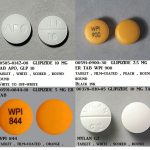
Contents
Ofloxacin vs. Erythromycin
Ofloxacin is a fluoroquinolone antibiotic used to treat bacterial infections such as pneumonia, bronchitis, staph infections, STDs (gonorrhea, chlamydia), urinary tract infections (UTIs), and prostate infections caused by E. coli. Other fluoroquinolone antibiotics include levofloxacin (Levaquin), ciprofloxacin (Cipro), gatifloxacin (Tequin), norfloxacin (Noroxin), moxifloxacin (Avelox), and trovafloxacin (Trovan). Ofloxacin stops bacterial multiplication by inhibiting genetic material (DNA) reproduction and repair.
Erythromycin is a macrolide antibiotic used to treat bacterial infections such as streptococcal infections of the throat ("strep throat") and skin, lung infections such as pneumonia, pelvic inflammatory disease, erythrasma, whooping cough, listeriosis, intestinal amebiasis, and STDs (syphilis, gonorrhea, and chlamydia). Erythromycin is used in patients allergic to penicillin for the prevention of recurrent rheumatic fever and infections of the heart valves (endocarditis) in patients with valvular abnormalities of the heart before dental treatments. Other macrolide antibiotics include azithromycin (Zithromax, Zmax) and clarithromycin (Biaxin). Erythromycin prevents bacterial cells from growing and multiplying by interfering with protein synthesis, without affecting human cells. Haemophilus influenzae bacteria are resistant to erythromycin alone and require a combination of erythromycin and sulfonamides for treatment.
What are the side effects of ofloxacin vs. erythromycin?
Ofloxacin
The common side effects of ofloxacin include:
Allergic reactions such as hives and anaphylaxis (shock) have been described.
Other important side effects include symptoms of nervous system stimulation:
Ofloxacin may cause low or high blood sugar levels, especially in people with diabetes who are taking insulin or oral hypoglycemic drugs.
Patients taking ofloxacin can develop skin sensitivity (photsensitivity) to direct sunlight and should avoid exposure or use sun protection and sunscreens.
Ofloxacin, like other fluoroquinolone antibiotics, has been associated with tendinitis and even tendon rupture, particularly the Achilles tendon. Some physicians recommend discontinuing vigorous exercise while taking fluoroquinolones.
Ofloxacin should be used with caution in patients with central nervous system diseases such as seizures because rare seizures have been reported in patients receiving this medication.
Ofloxacin is not recommended for use in children and adolescents under 18 years of age.
Many antibiotics, including ofloxacin, can alter the normal bacteria in the colon and encourage overgrowth of the bacterium responsible for colon inflammation (Clostridium difficile, pseudomembranous colitis). Pseudomembranous colitis can cause fever, abdominal pain, diarrhea, and sometimes even shock.
Ofloxacin should not be used in patients with myasthenia gravis because it can increase muscle weakness.
Erythromycin
The most frequent side effects of erythromycin are:
- nausea,
- vomiting,
- loss of appetite,
- diarrhea, and
- abdominal pain.
These gastrointestinal side effects are usually dose-related, more pronounced with higher doses.
Allergic reactions such as hives, rash, or anaphylaxis have been reported rarely.
What is the dosage of ofloxacin vs. erythromycin?
Ofloxacin
- The usual dose for patients with normal renal function is 200 to 400 mg every 12 hours.
- Dosages require adjustment in patients with severely abnormal liver or kidney function.
- Oflaxacin is available as tablets: 200, 300, and 400mg.
- Ofloxacin should be stored in a closed container at 15 C – 30 C (59 F – 86 F).
Erythromycin
- The usual dosage for adults is 250 mg every 6 hours, 333 mg every 8 hours, or 500 mg every 12 hours. Doses may be increased up to 4 g/day depending on the severity of the infection.
- In children, the usual dosage is 30 to 50 mg/kg/day, considering age, weight, and severity of the infection.
- Erythromycin may be taken with or without food; however, optimal blood levels are obtained when taken on an empty stomach (at least 30 minutes to 2 hours before or after meals).
What drugs interact with ofloxacin and erythromycin?
Ofloxacin
Ofloxacin reduces the elimination of theophylline, elevating blood levels. It can enhance the action of the anticoagulant warfarin, increasing the risk of bleeding. Both high and low blood sugar levels have been reported, especially in patients with diabetes who were also receiving insulin or other blood sugar-lowering medications. Careful monitoring is recommended. Certain medications should not be taken within two hours before or after taking ofloxacin, including sucralfate, iron, multivitamins containing zinc, didanosine, and antacids containing calcium, magnesium, or aluminum.
Erythromycin
Erythromycin may cause abnormal heart rhythms when used with antiarrhythmic drugs such as amiodarone, bretylium, disopyramide, dofetilide, procainamide, quinidine, and sotalol. Theophyllines reduce erythromycin blood levels, while erythromycin inhibits the metabolism of theophyllines, causing increased blood levels. This can lead to side effects such as seizures and disturbances in heart rhythm. Combining erythromycin with ergotamine or ydroergotamine can cause acute ergot toxicity. Erythromycin prevents digoxin from being eliminated by the kidneys, increasing digoxin levels in the blood and potentially causing disturbances in heart rhythm. Erythromycin also prevents the elimination of warfarin, raising warfarin levels in the blood and increasing the risk of bleeding. Erythromycin inhibits the breakdown of statins, leading to increased levels in the blood. High statin levels can cause severe myopathy with rhabdomyolysis. Erythromycin also increases blood levels of sildenafil. Grapefruit juice can prevent the breakdown of erythromycin, resulting in elevated levels in the blood.
By clicking Submit, I agree to the MedicineNet’s Terms & Conditions & Privacy Policy and understand that I may opt out of MedicineNet’s subscriptions at any time.


